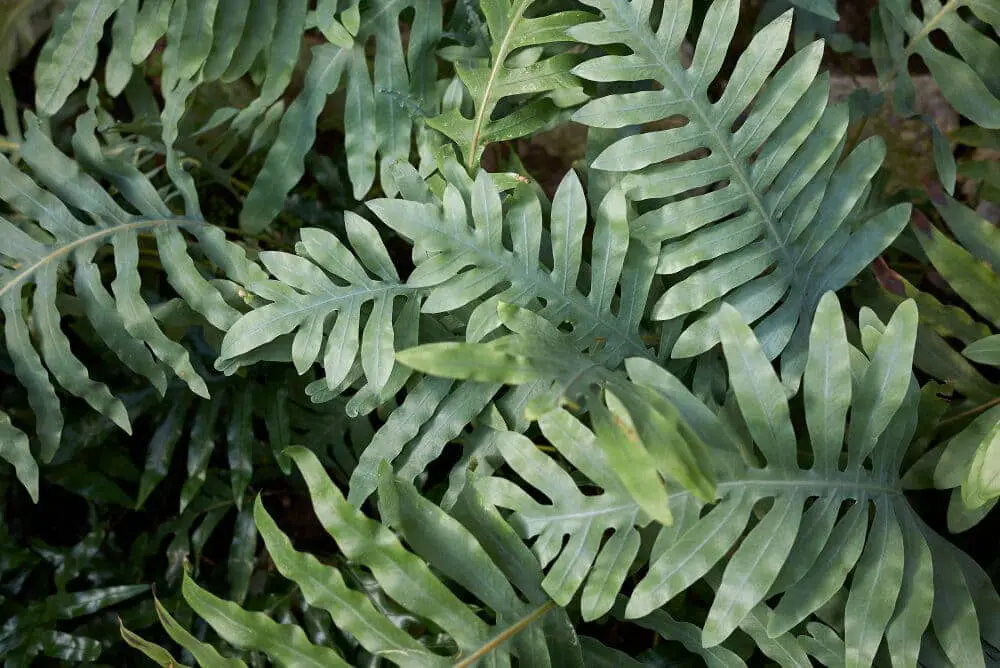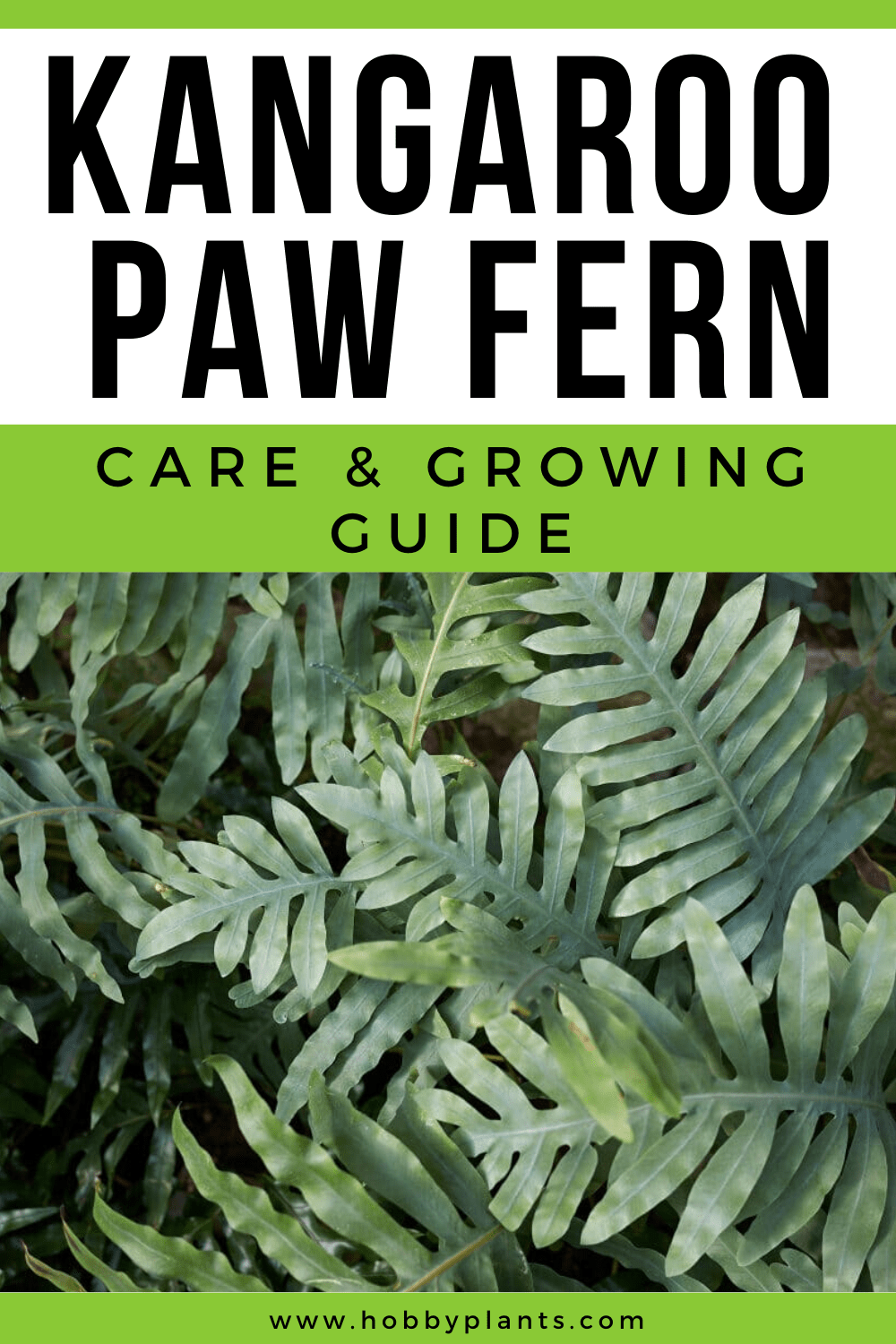As the name indicates, this is a plant that is native to Australia and New Zeland. It is usually grown for ornamental reasons in the ground or planters.
They add an exotic flair to your home or floral arrangements. There are about 12 species of this type of fern and they are perennials.
Kangaroo Paw Fern Care & Growing Guide
1. Light Requirement
When you grow this outside, they need to be kept in the shade. Indoors in a planter, the Kangaroo Paw Fern will need indirect, bright light. In the wintertime, they need brighter light.
2. Water
The Kangaroo Paw Fern needs even, regular moisture year-round to properly grow. Each week, you should make sure that your plant is getting an inch of water. The Kangaroo Paw Fern needs that deep watering once a week but also needs a light watering each day. It is not necessary to water it each day if it is an outdoor plant and gets rainwater and the soil feels damp to you. Do not flood the outdoor plant or let the indoor plant sit in water. It does not do well in soggy soil. To help retain its soil moisture, you can cover the soil with a two-three inch deep layer of pine straw mulch.
Watering the Kangaroo Paw Fern with distilled water or rainwater will help to improve its performance. In the winter, it is not actively growing so you should reduce the watering in half.
3. Climate
USDA Hardiness Zone 9-11
4. Soil
The soil needs to be moist but not soggy. The best type of soil would be a porous coarse soil that is well-draining. The pH should be 5.8. For indoor growing, use organic potting soil with a few scoops of regular play sand.
To help maintain a Kangaroo Paw Fern’s color, you want to make sure that it has a proper nutrient balance. To help with this, use a balanced, slow-release fertilizer in the spring with the new growth begins. You should use about a teaspoon of a granulated fertilizer for every four feet of soil surface. After spreading the fertilizer, you need to lightly water it. After three months, reapply the fertilizer if the environment temperature is around 70 degrees Fahrenheit. Do not over apply the fertilizer because this plant burns easily.
5. Temperature
A Kangaroo Paw Fern likes to have warm temperatures that range from 70-75 degrees Fahrenheit in the spring, summer, and fall. In the wintertime, they like cooler temperatures that range from 60-65 degrees Fahrenheit.

6. Repotting
After a few years of growth, the Kangaroo Paw Fern will generally outgrow its planter and have to be divided. You may need to repot it sooner if the leaves remain small or the center of the plant appears to be hollow. You should do this in the fall or spring as soon as new growth starts to appear. Dig it up carefully and plant it at the same soil depth as in the previous container.
The new container should be at least two inches larger in diameter. If you want to divide it into more plants at this time, use a sharp knife to cut the rhizome in half and separate the plant gently. Plant each half in the soil with about two inches of peat moss, leaf mold, or aged compost. Keep each plant in a shady area, water them, but avoid fertilizing until the plants until the following year so they will have time to recover from the transplant.
7. Speed of Growth
It does not state how fast it grows
8. Height and Spread
When the plant is mature, it can be 2-10 feet tall and one to two feet wide.
9. Flowers
The Kangaroo Paw Fern has firm leathery-type fronds that vary in size and are oddly shaped. The flowers are similar to an Amaryllis or Daylilies plant. The tubular flowers give an appearance of an animal paw and are covered with velvety dense fuzz, which gives them their color, which can be orange, red, or yellow. There are also some pink and white types.
10. Trimming
As soon as they appear, you should remove any dead fronds. You can cut them from the soil line.
Is Kangaroo Paw Fern Poisonous?
No, they are non-toxic to humans or animals
Can Kangaroo Paw Fern Grow in Water?
No, they need to be grown in soil, even when you are starting new plants.
How to get Kangaroo Paw Fern to Flower?
Make sure that they have the right light, soil, and water and that the pot is not overcrowded.
More like this: Rubber plant Care & Growing Guide
Common Kangaroo Paw Fern Plant Diseases
Kangaroo Paw Fern is prone to a variety of diseases, including:
- Aphids—you can get rid of them by spraying the fern with a hose or spray bottle, knocking them off. You can also use a soapy mixture to spray the fern once a week.
- Slugs—to get rid of these, you can just pick them off or use a light layer of diatomaceous earth on the soil and around the fern. Make sure that the diatomaceous earth does not get on the base of the fern. You may have to reapply this after rain to maintain an effective barrier around the plant.
- Inkspot disease—the leaves and stems will blacken so remove any damaged foliage. To prevent it, do not overcrowd the pot, keep the soil light, and give it a little extra sunlight.
Also read:
Conclusion
- You should not use insecticides on a Kangaroo Paw Fern because they are very sensitive to them.
- Occasionally wipe off the leaves with a damp cloth to get rid of any dirt or dust.
- The scientific name is Microsorum diversifolium and refers to the different leaf forms that are found on the Kangaroo Paw Fern.
- On mature plants, some of the leaves have deep indentations while others are smooth.
- Unless you live in a warm climate, this fern is more suited for growing indoors but on warm sunny days, you can bring the planter outdoors and put in partial shade.
The Kangaroo Paw Fern is epiphytic, which means that they can grow in cracks in rocks, tree crotches, or logs.

Victoria is the owner and main author of hobby plants. She loves spending her free time in her garden planting and taking care of her plants. Victoria hopes you enjoy the content here!
![Queen Of The Night Flower [Complete Plant Care Guide] Queen Of The Night Flower [Complete Plant Care Guide]](https://www.hobbyplants.com/wp-content/uploads/2022/07/queen-of-the-night-flower-300x158.jpg)
![Mother Of Thousands Plant [Complete Plant Care Guide] Mother Of Thousands Plant [Complete Plant Care Guide]](https://www.hobbyplants.com/wp-content/uploads/2022/07/mother-of-thousands-plant-300x158.jpg)
![How Often Should You Water Pothos? [Complete Care Guide] How Often Should You Water Pothos? [Complete Care Guide]](https://www.hobbyplants.com/wp-content/uploads/2022/07/how-often-to-water-pothos-300x158.jpg)
![Can Snake Plants Live Outside? [COMPLETE CARE GUIDE] Can Snake Plants Live Outside? [COMPLETE CARE GUIDE]](https://www.hobbyplants.com/wp-content/uploads/2022/08/can-snake-plants-live-outside-300x158.jpg)
![Majesty Palm Plant Care: [Complete Beginner's Guide] Majesty Palm Plant Care: [Complete Beginner's Guide]](https://www.hobbyplants.com/wp-content/uploads/2022/08/majesty-palm-care-300x158.jpg)
![Exotic Angel Plant Care: [Complete Beginner's Guide] Exotic Angel Plant Care: [Complete Beginner's Guide]](https://www.hobbyplants.com/wp-content/uploads/2022/08/exotic-angel-plant-care-300x158.jpg)
![Do Coleus Like Sun Or Shade: [Complete Care Guide] Do Coleus Like Sun Or Shade: [Complete Care Guide]](https://www.hobbyplants.com/wp-content/uploads/2022/08/coleus-sun-or-shade-300x158.jpg)
![Snow White Waffle Plant: [Complete Care Guide] Snow White Waffle Plant: [Complete Care Guide]](https://www.hobbyplants.com/wp-content/uploads/2022/08/snow-white-waffle-plant-300x158.jpg)
![Waffle Plant Care: [Complete Beginner's Guide] Waffle Plant Care: [Complete Beginner's Guide]](https://www.hobbyplants.com/wp-content/uploads/2022/08/waffle-plant-300x158.jpg)
![Bird Of Paradise Plant Care: [Complete Beginner's Guide] Bird Of Paradise Plant Care: [Complete Beginner's Guide]](https://www.hobbyplants.com/wp-content/uploads/2022/08/bird-of-paradise-plant-300x158.jpg)
![Purple Passion Plant Care: [Complete Beginner's Guide] Purple Passion Plant Care: [Complete Beginner's Guide]](https://www.hobbyplants.com/wp-content/uploads/2022/08/purple-passion-plant-care-300x158.jpg)
![China Doll Plant Care: [Complete Beginner's Guide] China Doll Plant Care: [Complete Beginner's Guide]](https://www.hobbyplants.com/wp-content/uploads/2022/09/china-doll-plant-care-300x158.jpg)